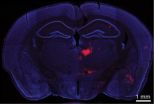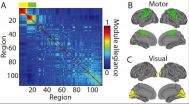Into thin air and back
New deer mouse study examines muscle performance and high altitude adaptation
2015-04-08
(Press-News.org) Life has adapted to all sorts of extreme environments on Earth, among them, animals like the deer mouse, shimmying and shivering about, and having to squeeze enough energy from the cold, thin air to fuel their bodies and survive.
Now, in a new publication in the journal Molecular Biology and Evolution, Scott, Cheviron et al., have examined the underlying muscle physiology from a group of highland and lowland deer mice. Deer mice were chosen because they exhibit the most extreme altitude range of any North American mammal, occurring below sea levels in Death Valley to more than 4,300 meters high in the mountains.
The research team took mice native to high or low altitude habitats, and after rearing the lab, measured the population differences in the mice, as well as their offspring. Many muscle physiology traits tended to show heritable differences between populations, whereas many were more plastic, changing with acclimation to a new altitude environment.
These differences were associated with changes in the expression of in a number of genes involved in energy metabolism, muscle plasticity, vascular development and cellular stress. At the intracellular level, genes that influence the proliferation of the powerhouses of the cell, mitochondria, were also more highly expressed in highland mice. Together these genetic changes resulted in increasing the oxidative capacity and blood supply to skeletal muscle, where rivers and tributaries of blood vessels and capillaries serve to enrich and energize skeletal muscle.
The results add to the growing knowledge and underlying mechanisms of fitness-related physiological performance under hypoxic conditions.
INFORMATION:
ELSE PRESS RELEASES FROM THIS DATE:
2015-04-08
Cold Spring Harbor, NY - The prefrontal cortex (PFC) plays an important role in cognitive functions such as attention, memory and decision-making. Faulty wiring between PFC and other brain areas is thought to give rise to a variety of cognitive disorders. Disruptions to one particular brain circuit--between the PFC and another part of the brain called the thalamus--have been associated with schizophrenia, but the mechanistic details are unknown. Now, Cold Spring Harbor Laboratory scientists have discovered an inhibitory connection between these brain areas in mice that ...
2015-04-07
The Burgess Shale Formation, in the Canadian Rockies of British Columbia, is one of the most famous fossil locations in the world. A recent Palaeontology study introduces a 508 million year old (middle Cambrian) arthropod--called Yawunik kootenayi--from exceptionally preserved specimens of the new Marble Canyon locality within the Burgess Shale Formation.
Its frontal appendage--the "megacheiran great appendage"--is remarkably adorned with teeth, emphasizing an advanced predatory function. The appendage also had long hair-like flagella at the end that likely served a sensory ...
2015-04-07
Why do some people learn a new skill right away, while others only gradually improve? Whatever else may be different about their lives, something must be happening in their brains that captures this variation.
Researchers at the University of Pennsylvania, the University of California, Santa Barbara, and Johns Hopkins University have taken a network science approach to this question. In a new study, they measured the connections between different brain regions as participants learned to play a simple game. The differences in neural activity between the quickest and slowest ...
2015-04-07
The results appear in the 2015 2nd issue of the journal of Human Genome Variation. To see a video about the partnership between Champions and Insilico, visit: http://tinyurl.com/InsilicoChampions .
Colorectal cancer (CRC) is the third most commonly diagnosed cancer and the second leading cause of cancer deaths in the United States. More than 50,000 people die of CRC each year due to tumor spreading to other organs and almost half of all newly diagnosed patients are in an advanced stage of cancer (metastatic CRC or mCRC) when they are first diagnosed.
With the development ...
2015-04-07
A Northwestern University research team potentially has found a safer way to keep blood vessels healthy during and after surgery.
During open-heart procedures, physicians administer large doses of a blood-thinning drug called heparin to prevent clot formation. When given too much heparin, patients can develop complications from excessive bleeding. A common antidote is the compound protamine sulfate, which binds to heparin to reverse its effects.
"Protamine is a natural compound that has been used in surgeries for many decades," said Guillermo Ameer, professor of biomedical ...
2015-04-07
The combination of two well-known drugs will have unprecedented effects on pain management, says new research from Queen's.
Combining morphine, a narcotic pain reliever, and nortriptyline, an antidepressant, has been found to successfully relieve chronic neuropathic pain - or a localized sensation of pain due to abnormal function of the nervous system - in 87 per cent of patients, and significantly better than with either drug alone.
"Chronic pain is an increasingly common problem and can exert disastrous personal, societal, and socio-economic impacts on patients, their ...
2015-04-07
In the largest study of its kind to date, researchers at Stanford University School of Medicine and their colleagues have found that worldwide only a limited number of mutations are responsible for most cases of transmission of drug-resistant HIV.
HIV, the virus that causes AIDS, can mutate in the presence of antiviral drugs, and these mutations can be transmitted from one person to the next.
In the new study of more than 50,000 patients in 111 countries, the researchers found a small group of mutations accounted for a majority of the cases of transmission-related resistance ...
2015-04-07
Washington, DC (April 7, 2015) - Greater availability of percutaneous mechanical circulatory support (MCS) devices for treatment of heart failure is helping expand treatment options for a rapidly growing number of acutely and chronically ill cardiac patients who could benefit from the devices. An expert consensus statement released today by the Society for Cardiovascular Angiography and Interventions (SCAI), American College of Cardiology (ACC), Heart Failure Society of America (HFSA) and The Society of Thoracic Surgeons (STS) provides new guidance to help physicians match ...
2015-04-07
Only a limited number of surveillance drug-resistance mutations (SDRMs) are responsible for most instances of non-nucleoside reverse transcriptase inhibitor (NNRTI)- and nucleoside reverse transcriptase inhibitor (NRTI)-associated resistance, and most strains of HIV-1 transmitted drug resistance (TDR) in sub-Saharan Africa (SSA) and south/southeast Asia (SSEA) arose independently, according to a study published this week in PLOS Medicine. The study, led by Soo-Yon Rhee of Stanford University, and colleagues, came to these conclusions after analyzing individual virus sequences ...
2015-04-07
While other studies have shown that stress and negative marital quality can influence mortality and blood pressure, there has not been research that discussed how it might affect married couples over time. Using systolic blood pressure as a gauge, researchers assessed whether an individual's blood pressure is influenced by their own as well as their partner's reports of chronic stress and whether there are gender differences in these patterns.
The Journals of Gerontology, Series B®: Psychological Sciences published these findings in the article titled, "Stress and ...
LAST 30 PRESS RELEASES:
[Press-News.org] Into thin air and back
New deer mouse study examines muscle performance and high altitude adaptation


